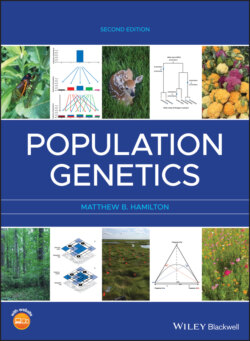Читать книгу Population Genetics - Matthew B. Hamilton - Страница 22
2.2 Hardy–Weinberg expected genotype frequencies
ОглавлениеHardy–Weinberg and its assumptions.
Each assumption is a population genetic process.
Hardy–Weinberg is a null model.
Hardy–Weinberg in haplo‐diploid systems.
Mendel's “laws” could be called the original expectations in population genetics. With the concept of particulate genetics established, it was possible to make a wide array of predictions about genotype and allele frequencies as well as the frequency of phenotypes with a one‐locus basis. Still, progress and insight into particulate genetics were gradual. Until 1914, it was generally believed that rare (infrequent) alleles would disappear from populations over time. Godfrey H. Hardy (1908) and Wilhelm Weinberg (1908) worked independently to show that the laws of Mendelian heredity did not predict such a phenomenon (see Crow 1988). In 1908, they both formulated the relationship that can be used to predict allele frequencies given genotype frequencies or predict genotype frequencies given allele frequencies. This relationship is the well‐known Hardy–Weinberg equation.
(2.1)
where p and q are allele frequencies for a genetic locus with two alleles.
Genotype frequencies predicted by the Hardy–Weinberg equation can be summarized graphically. Figure 2.5 shows Hardy–Weinberg expected genotype frequencies on the y axis for each genotype for any given value of the allele frequency on the x axis. Another graphical tool to depict genotype and allele frequencies simultaneously for a single locus with two alleles is the de Finetti diagram (Figure 2.6). As we will see, de Finetti diagrams are helpful when examining how population genetic processes dictate allele and genotype frequencies. In both graphs, it is apparent that heterozygotes are most frequent when the frequency of the two alleles is equal to 0.5. You can also see that when an allele is rare, the corresponding homozygote genotype is even rarer since the genotype frequency is the square of the allele frequency.
A single generation of reproduction where a set of conditions, or assumptions, is met will result in a population that meets Hardy–Weinberg expected genotype frequencies, often called Hardy–Weinberg equilibrium. The list of assumptions associated with this prediction for genotype frequencies is long. The set of assumptions includes:
Figure 2.5 Hardy–Weinberg expected genotype frequencies for AA, Aa, and aa genotypes (I‐axis) for any given value of the allele frequency (x‐axis). Note that the value of the allele frequency not graphed can be determined by q = 1 – p.
the organism is diploid,
reproduction is sexual (as opposed to clonal),
generations are discrete and non‐overlapping,
the locus under consideration has two alleles,
allele frequencies are identical among all mating types (i.e. sexes),
mating is random (as opposed to assortative),
there is random union of gametes,
population size is very large, effectively infinite,
migration is negligible (no population structure, no gene flow),
mutation does not occur or its rate is very low,
natural selection does not act (all individuals and gametes have equal fitness).
These assumptions make intuitive sense when each is examined in detail (although this will probably be more apparent after more reading and simulation). As we will see later, Hardy–Weinberg holds for any number of alleles, although Eq. 2.1 is valid for only two alleles. Many of the assumptions can be thought of as assuring random mating and production of all possible progeny genotypes. Hardy–Weinberg genotype frequencies in progeny would not be realized if the two sexes have different allele frequencies even if matings take place between random pairs of parents. It is also possible that just by chance not all genotypes would be produced if only a small number of parents mated, just like flipping a fair coin only a few times may not produce an equal number of heads and tails. Natural selection is a process that causes some genotypes in either the parental or progeny generations to be more frequent than others. So, it is logical that Hardy–Weinberg expectations would not be met if natural selection were acting. In a sense, these assumptions define the biological processes that make up the field of population genetics. Each assumption represents one of the conceptual areas where population genetics can make testable predictions via expectation in order to distinguish the biological processes operating in populations. This is quite a set of accomplishments for an equation with just three terms!
Figure 2.6 A de Finetti diagram for one locus with two alleles. The triangular coordinate system results from the requirement that the frequencies of all three genotypes must sum to one. Any point inside or on the edge of the triangle represents all three genotype frequencies of a population. The parabola describes Hardy–Weinberg expected genotype frequencies. The dashed lines represent the frequencies of each of the three genotypes between zero and one. Genotype frequencies at any point can be determined by the length of lines that are perpendicular to each of the sides of the triangle. A practical way to estimate genotype frequencies on the diagram is to hold a ruler parallel to one of the sides of the triangle and mark off the distance on one of the frequency axes. The point on the parabola is a population in Hardy–Weinberg equilibrium where the frequency of AA is 0.36, the frequency of aa is 0.16, and the frequency of Aa is 0.48. The perpendicular line to the base of the triangle also divides the bases into regions corresponding in length to the allele frequencies. Any population with genotype frequencies not on the parabola has an excess (above the parabola) or deficit (below the parabola) of heterozygotes compared to Hardy–Weinberg expected genotype frequencies.
